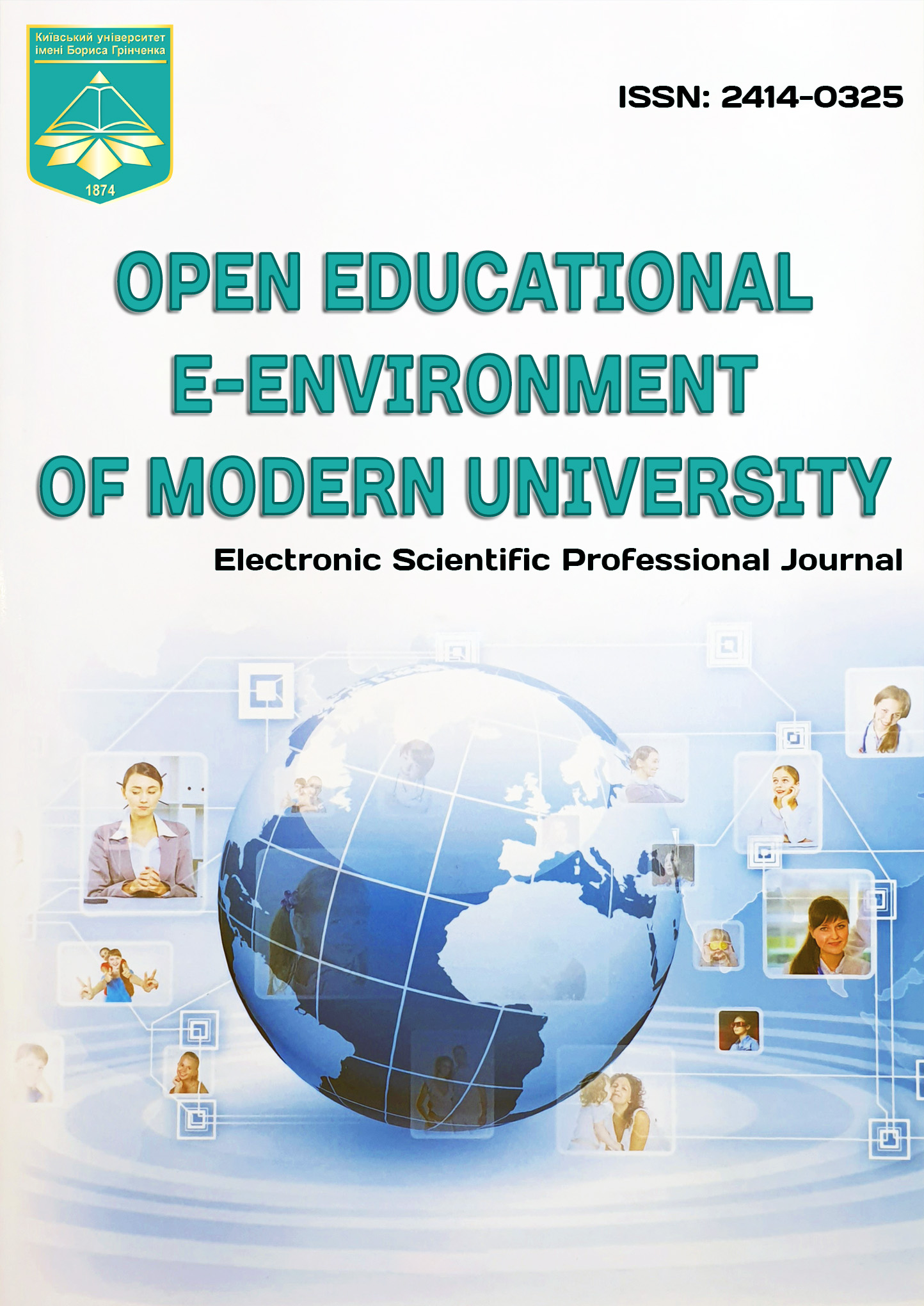MUSIC AND SONG TOOLS FOR ENGLISH LANGUAGE COMPETENCE DEVELOPMENT FOR YOUNG LEARNERS: OPPORTUNITIES OF DIGITAL TECHNOLOGIES
DOI:
https://doi.org/10.28925/2414-0325.2023.156Keywords:
digital technologies; English; young learner; lesson; song; musicAbstract
One of the interesting tools of learning at English lessons is music and songs. Their purpose as a didactic tool is to develop English language competence, to impact on the emotional and sensory sphere of young learners, it is like a game for quick studying of learning material, raising interest, curiosity, enthusiasm at English lessons. The purpose of the research is to characterize the use of music and song tools at English lessons with the possibility of using digital technologies. The tasks of the research are to analyze different authors’ approaches to defining the basics of music and song tools; outline their influence on various aspects of the language; give examples of digital technologies practice using music and song material at English lessons. The results of the research show that music and song tools are teaching tools based on the introduction of rhythmic song material in teaching English for young learners. The use of chants contributes to the contextual introduction of lexical units and speech patterns, easier and faster memorization of English language material. At an English language lesson, it is necessary to use digital technologies to create an artificial English-speaking environment using authentic songs from websites, YouTube, Tik Tok, etc. When using digital technologies, an English language teacher in primary grades should follow three simple stages while implementing a song: pre-listening tasks, while-listening tasks, after-listening tasks as singing a song, creative tasks. Some songs provide the opportunity to perform various physical movements while singing, that relieves physical tension during English lessons (songs like "Head, Shoulders, Knees and Toes", "Can You Clap" and others). Therefore, the use of digital technologies does not involve only learning young learners in front of computer screens, it should be combined with the physical movements for young learners. It is recommended using a variety of digital resources at primary English lessons, such as the British Council's LearnEnglish Kids resource with lots of songs and tasks. So, the conclusion is digital technologies contribute to the use of music and song as a learning tool that expands the motivation of young learners and contributes to the development of English language competence.
Downloads
References
Kostikova, I., Gulich, O., Holubnycha, L., & Besarab, T. (2019). Interactive whiteboard use at English lessons: from university students to young learners. Revista Espacios, №40(12). http://www.revistaespacios.com/a19v40n12/a19v40n12p10.pdf
Setyaningsih, A. (2016). Teaching English to Young Learners Through Songs. Journal of English and Education. №1б pp.75-85. http://dx.doi.org/10.20885/jee.vol1.iss2.art7
Millington, N. T. (2011). Using Songs Effectively to Teach English to Young Learners. Language Education in Asia. №2(1). pp. 134-141. https://leia.org/LEiA/LEiA%20VOLUMES/Download/LEiA_V2_I1_2011/LEiA_V2I1A11_Millington.pdf
Lems, K. (2018). New Ideas for Teaching English Using Songs and Music. English teaching forum. https://americanenglish.state.gov/files/ae/resource_files/etf_56_1_pg14-21_0.pdf
Bastidas, J.A. (2002). How to Use Songs in the EFL/ESL class. MEXTESOL. Mexico: Mextesol Association, №25(3), pp. 47-62. http://www.mextesol.net/journal/public/files/109929c7b5ba774809f0d8071178b9e8.pdf
Vasylenko, O. & Sysojenko, I. (2014). Small poetic forms as a means of activating students' cognitive activity in English lessons. Naukovyj chasopys Nacionaljnogho pedaghoghichnogho universytetu imeni M.P.Draghomanova № 05, Pedaghoghichni nauky: realiji ta perspektyvy, № 49, pp. 42-47. http://enpuir.npu.edu.ua/bitstream/123456789/15726/1/Vasilenko_Sisoenko.pdf (in Ukrainian)
Ghusak-Shklovsjka, Ja. D. (2013). Functional music as a way of increasing work capacity and improving well-being. Kharchova nauka i tekhnologhija, № 1, pp. 52-55. http://nbuv.gov.ua/UJRN/Khnit_2013_1_19http://irbis-nbuv.gov.ua/cgi-bin/irbis_nbuv/cgiirbis_64.exe?C21COM=2&I21DBN=UJRN&P21DBN=UJRN&IMAGE_FILE_DOWNLOAD=1&Image_file_name=PDF/Khnit_2013_1_19.pdf (in Ukrainian)
Lokarjeva, Gh. V. (2016). Possibilities of using music therapy in general educational institutions. Mystectvo ta osvita, №4, pp. 7-11. http://catalog.library.tnpu.edu.ua:8080/library/DocDescription?doc_id=627942 (in Ukrainian)
Karpenko, Gh. M. (2020). A musical way of learning English as an innovative method of strengthening communicative competence. Vcheni zapysky TNU imeni V. I. Vernadsjkogho. Serija: Filologhija. Socialjni komunikaciji. Ghermansjki movy. №31(70), №2, I.2. pp. 103-107. DOI https://doi.org/10.32838/2663-6069/2020.2-2/18 (in Ukrainian)
Polenok, Z. V. (2009). Use of song text material in English lessons, Inozemni movy, № 2, pp. 9-11.
Fuchyla, O.M. (2007). The use of songs in the process of learning English. Visnyk nacionaljnogho universytetu «Ljvivsjka politekhnika». Problemy linghvistyky naukovo-tekhnichnogho i khudozhnjogho tekstu ta pytannja linghvometodyky, № 586, pp.42-46 http://vlp.com.ua/files/13_36.pdf (in Ukrainian)
Pavljuk, R. (2008). The technology of using jazz chants in foreign language lessons as a means of increasing the socio-cultural competence of younger schoolchildren. Imidzh suchasnogho pedaghogha, Poltava: ASMI, №9-10(88-89), pp. 96-98. https://elibrary.kubg.edu.ua/id/eprint/1601/1/R_Pavlyuk_ISP_9-10_FMLD_PI.pdf (in Ukrainian)
Macancela, J. M. (2019). Websites as support tools for learning the English language. Journal of Science and Research: Revista Ciencia E Investigacion, №4(2), pp.13-20. https://doi.org/10.5281/zenodo.3240647
Mindari, R., Sriemulyaningsih, M.J. & Joewono, A. (2019). Young Learners’ Responses on the Use of Animation in an English Class. Magister Scientiae, № 46, pp.274-285. https://doi.org/10.33508/mgs.v2i46.2232
Okai-Ugbaje, S., Ardzejewska, K., Imran, A., Yakubu, A., & Yakubu, M. (2020). Cloudbased m-learning: A pedagogical tool to manage infrastructural limitations and enhance learning. International Journal of Education and Development using Information and Communication Technology, №16(2), pp. 48-67. https://files.eric.ed.gov/fulltext/EJ1268798.pdf
Pangaribuan, T., Sinaga, A., & Sipayung, K. T. (2017). The Effectiveness of Multimedia Application on Students Listening Comprehension. English Language Teaching. №10(12), pp.212-218. http://doi.org/10.5539/elt.v10n12p212
Renukadevi, D. (2014). The Role of Listening in Language Acquisition; the Challenges & Strategies in Teaching Listening. International Journal of Education and Information Studies, №4(1), pp.59-63. https://www.ripublication.com/ijeisv1n1/ijei sv4n1_13.pdf
Safranj, J. (2015). Advancing listening comprehension through movies. Procedia – Social and Behavioral Sciences, №191, pp. 169-173. https://doi.org/10.1016/j.sbspro.2015.04.513
Zhen, Z. (2016). The Use of Multimedia in English Teaching. US-China Foreign Language, №14(3), pp.182-189. https://doi.org/10.17265/1539-8080/2016.03.002
Kostikova I., Chastnyk O., Ptushka A., Yazlovytska O., & Dovzhenko O. (2021). Digital technology implementation in students’ proficiency development for English listening. Amazonia Investiga, №10(48), pp.34-42. https://doi.org/10.34069/AI/2021.48.12.4
Published
How to Cite
Issue
Section
License
Copyright (c) 2023 Kostikova I., Jiang H.

This work is licensed under a Creative Commons Attribution-NonCommercial-ShareAlike 4.0 International License.













1.jpg)








